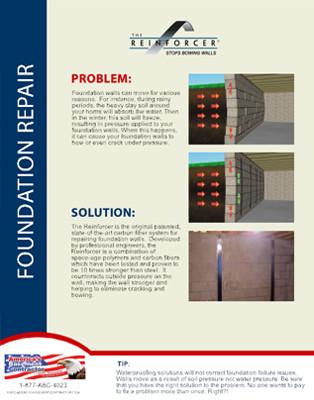Bowed Wall Repair
This is a common structural problem seen on homes all over the area. It’s caused by excess hydrostatic pressure in the soil surrounding the home. Whenever a house is built in clay-rich soil, it quickly absorbs moisture from rainfall and melting snow very quickly. When this happens, it causes the earth to swell, and puts a lot of force on basement walls. Eventually, the force proves to be too much, and the walls will start to lean into the home. Horizontal or vertical wall cracks may also accompany this problem on the affected surface. It is a problem that needs to be looked at and taken care of sooner rather than later to avoid additional damage or problems for the structural integrity of your home.
Grip-Tite® Wall Anchors
To take care of the problem, our team uses anchors installed deep within the earth in stable, load-bearing strata. On the inside of the home, a special plate is mounted on the damaged wall. The anchor and plate are then connected to one another with a strong steel rod. The rod can be tightened over time to provide the necessary lateral pressure needed to counteract the force coming from the soils in the earth.
Advantages
- Can straighten a wall without having to rebuild it
- Limited disturbance to your yard and landscaping
- Low-profile wall plate
- Stabilize leaning and bowing walls with ease
- Allowable rod capacity – 8,400 lbs.
The Reinforcer® Carbon Fiber Wall Reinforcement System
In addition to anchors, our crew can also install these powerful strips to your leaning walls. They can provide an incredible amount of strength and can help to stabilize even the weakest of surfaces. We work with two different types of products from NASH®, and they are known as The Reinforcer® Plate (strap system), and The Reinforcer® Shield, which is often used for irregularly shaped repair work.
Advantages
- No heavy equipment is needed for installation
- No dusty or messy concrete to worry about
- Non invasive installation


